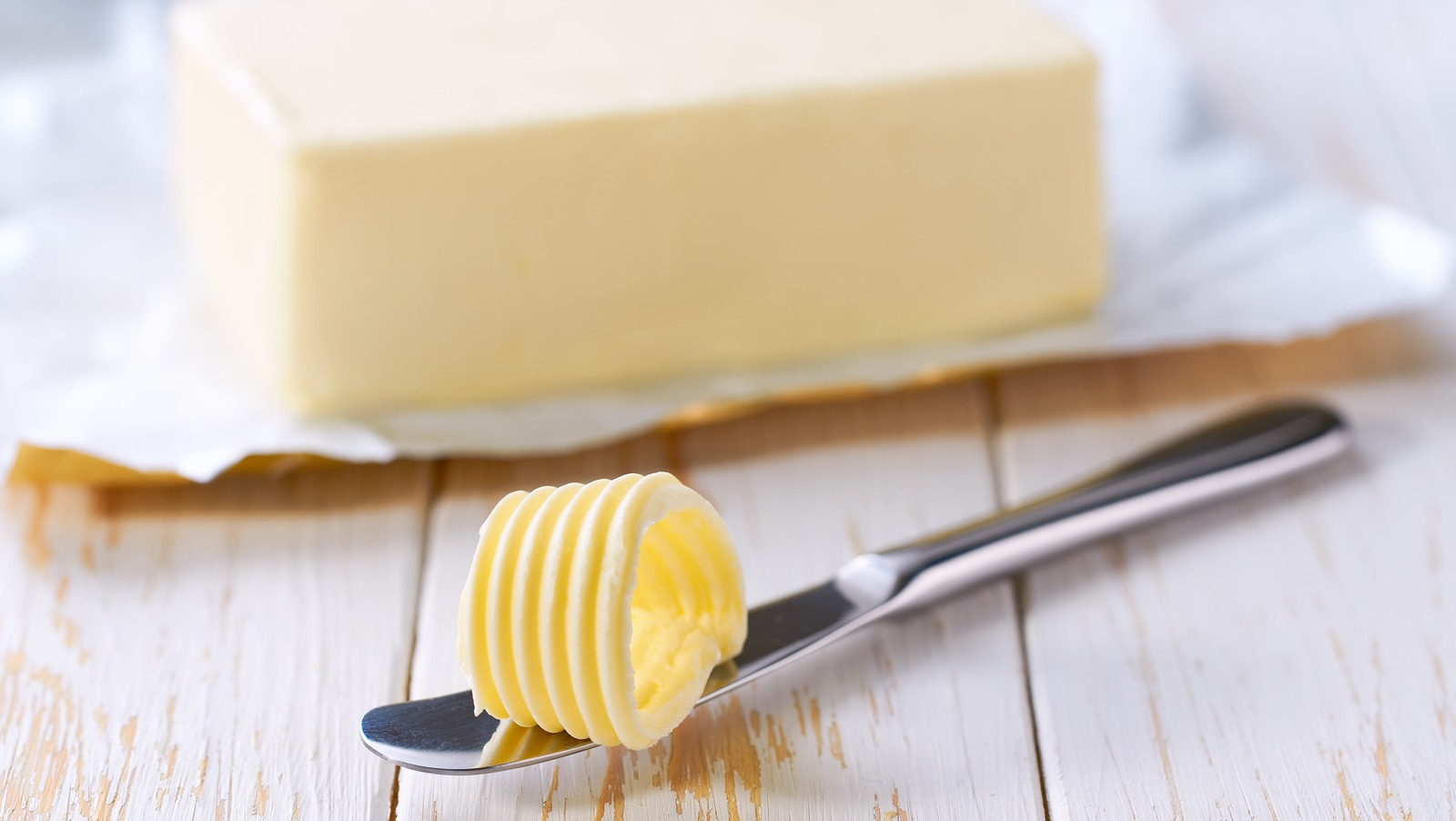
Butter is a staple in most refrigerators. In fact, in 2022, the average American consumed six pounds of the dairy product annually, or the equivalent of 12 cups or 24 sticks of butter. This ubiquitous kitchen staple is a go-to spread for toast and is commonly used in a wide range of recipes, from pasta sauces to baked goods.
Typically made from cow milk or cream, in the U.S., butter must contain at least 80% milk fat, which gives it a rich, velvety texture.
Dating back some 9,000 years, butter has ancient roots. It's believed that butter was first discovered by accident, possibly when milk was stored in sheep skins and naturally churned during long journeys on horseback. Thousands of years later, butter continues to hold its own as a beloved ingredient across the globe.
More specifically, it's the rich flavor and smooth texture of this dairy product that has made it indispensable in so many culinary traditions. Despite its popularity, however, butter is still sometimes misused or simply not utilized to its full potential. Keen to find out how to make the most of this classic ingredient? Keep reading! 1.
Choose the right butter There are many different , each with its own flavor, consistency, and uses. While some can be substituted for one another in recipes, others are best suited to specific cooking endeavors. The most well-known butter type, which can be found on most supermarket shelves, is unsalted butter.
This type of butter is normally used as a spread, in baking, and for making . Salted butter is also very popular and works well as a spread on toast and an addition to recipes that require salt. For a more robust, subtly tangy flavor on your toast or in baking, use cultured butter or European butter.
Both butter types have a high butterfat content, which gives them a richer flavor and creamier texture than regular butter. Meanwhile, compound butter contains herbs and spices for a bolder flavor, making it ideal for topping steak and seafood. Finally, clarified butter and ghee are ideal for high-heat cooking such as sautéing and frying.
This is because they both have high smoke points, which makes them less likely to burn. 2. Make your own butter at home While making your own butter may seem like a daunting task, it's actually surprisingly easy.
Best of all, you don't even need any equipment for the job that you probably don't already have in your kitchen. To make your own butter, simply place room-temperature cream in a processor and let it run. Alternatively, you can pour the cream into a jar and use some good old-fashioned elbow grease to shake it vigorously for around 20 minutes.
As it's agitated, the dairy will gradually thicken to the consistency of whipped cream before separating into buttermilk and milk solids. Once you notice a distinct division between the soft clumps of butter and the liquid buttermilk, carefully pour off the buttermilk into a separate container using a fine mesh sieve. Rather than discarding it, you can use the buttermilk to make pancakes, biscuits, and even mashed potatoes.
Finally, rinse the butter under cold water to remove any residual buttermilk, since leaving it behind is likely to cause the butter to spoil faster. If necessary, use your hands to squeeze out any excess liquid from the butter. 3.
Make sure that the butter is at the right temperature when incorporating it into a recipe While it may seem insignificant, butter temperature can have a notable impact on your culinary endeavors. If a recipe calls for room-temperature butter, this is exactly what you should be using — butter that's between 65 and 70 degrees Fahrenheit. Butter taken straight out of the freezer or one that's been overheated in the microwave will simply not perform the same way.
To soften butter, take it out of the refrigerator and leave it out for an hour or two, or until it reaches the desired temperature and pliability. Adding room-temperature butter to baking recipes is essential for the "creaming" process, where the butter traps air to give dough a light and fluffy texture. Using overly cold butter won't incorporate enough air into the dough, while butter that's too warm is likely to lead to flat and chewy baked goods.
It's important to remember that not all recipes require room temperature butter. For instance, should be made with cold butter. This is because soft butter won't create the tiny air pockets in the dough that ultimately result in a .
Even if a recipe requires melted butter, let it cool before throwing it into the mix, as hot butter can partially cook other ingredients before they are fully mixed. 4. Brown the butter for extra flavor In a nutshell, is butter that has been cooked until the milk solids begin to caramelize.
Also called beurre noisette in French, brown butter has a deliciously nutty flavor that can add depth to both sweet and savory recipes such as brownies and pancakes. So what's the science behind the browning process? Regular butter is made up of milk solids and butterfat. When butter is simmered on low to medium heat, the milk solids begin to toast, taking on a beautiful golden color and robust flavor.
Aside from the main ingredient, all you will need to make brown butter is a stovetop, a pan, a spatula, and a little bit of patience. Start by cutting the butter into uniform pieces to ensure that they melt evenly. Simmer and stir the butter until it bubbles and foams.
Be sure to remove the skillet from heat as soon as the milk solids turn golden-brown and the butter begins to smell toasted. When using brown butter in a recipe, measure it after the browning process is complete since the dairy will lose moisture during the cooking process. 5.
Don't burn the butter There is a fine line between brown butter and burnt butter. Once singed, butter becomes bitter and can leave unsightly black marks on your food. It can also ruin a perfectly good skillet.
Compared to other fats, butter burns relatively quickly since it has a low smoke point of 350 degrees Fahrenheit. In comparison, the smoke point of vegetable oil is between 400 and 450 degrees Fahrenheit, Canola oil is 400 degrees, peanut oil is 450 degrees, and sunflower oil is 510 degrees. Luckily, with a little know-how, you can ensure that your brown butter turns out perfectly every time.
First, it's best to use a light-colored pan so you can easily notice the changes in the color of the butter. In addition, never cook butter on high heat as it can go from brown to burnt almost instantly. Finally, once the butter is ready, remove it from the heat source, as well as from the skillet, so it doesn't continue cooking.
6. Mix butter with oil to prevent burning Compared to other fats, butter has a relatively low burning point of around 350 degrees Fahrenheit. This means that it's not the ideal choice for high-temperature cooking.
Luckily, there is an easy solution if you want to combine the rich flavor of butter with the higher smoke point of other oils. Firstly, you can use either clarified butter or ghee in your cooking, both of which have a higher smoke point than butter. Alternatively, you can mix butter with a high smoke-point oil.
The butter-and-oil combo can be particularly useful for searing meats such as steak or . Mixing these two ingredients allows you to both brown up the meat and infuse it with the creamy taste of butter. If you are after a neutral-flavored oil that won't interfere with the delicious richness of butter, opt for canola or vegetable oil, with smoke points ranging between 400 and 450 degrees Fahrenheit.
Alternatively, go for light or refined olive oil, which has a smoke point of around 465 degrees Fahrenheit. Those wishing to add extra depth to their dish can choose a flavored cooking oil with a high smoke point, such as peanut oil, grapeseed oil, or beef tallow. 7.
Make clarified butter at home The main advantage of is its high smoke point. While regular butter burns at around 350 degrees Fahrenheit, making it unsuitable for high-temperature cooking, clarified butter has a smoke point of 450 degrees Fahrenheit. This is because, unlike standard supermarket butter, clarified butter has been heated to remove water and milk solids, leaving behind only butterfat.
Since it's the milk solids that cause butter to burn at high temperatures, their absence makes clarified butter perfect for sautéing, searing, and frying. The great news is that you can easily clarify butter in the comfort of your own kitchen. Start by melting unsalted butter in a saucepan over low heat.
Be sure not to stir the butter, as it bubbles and foams. This is the stage when the milk solids settle at the bottom of the saucepan. Skim the foam floating on the surface with a spoon before taking the pan off the stove.
At this stage, you can either carefully pour the butterfat into a separate container, leaving the milk solids behind in the saucepan or strain the butter through a fine mesh sieve or cheesecloth to catch the milk solids and drain the butterfat. 8. Use butter for basting meat and seafood Commonly used to enhance the flavor when roasting and grilling meat and to prevent it from drying out, basting involves periodically covering food with its own juices and another liquid such as melted butter.
Butter basting can also give poultry a wonderfully crispy skin and add a rich crust to a steak. Aside from a crunchy outer, butter basting can imbue meat and fish with a deep caramelized flavor. This is because as the butter browns, it undergoes the Maillard reaction, which is a complex process that gives the dairy a rich, nutty flavor.
We're not going to lie, butter basting is a pretty hands-on process, since you need to repeatedly ladle the hot butter and fat mixture over the protein while it cooks. The best way to do this is to tilt the pan slightly and scoop up the pooled liquid before pouring it over the meat or fish. For extra flavor, infuse the fat with aromatics such as garlic, rosemary, sage, or thyme.
If you are concerned about burning the butter, one has some solid advice. "First get your pan screaming hot with a high smoke point oil. Throw the steak in and once you get the amount of crust you're looking for, turn the burner down to mid heat, give a little time for your pan to cool down, and add butter and herbs.
Then keep basting and flipping until you hit the internal temp you're looking for." 9. Avoid substituting butter with margarine in baking recipes While butter and margarine have different tastes and consistencies, they both work well as spreads.
Made from cream, butter has a rich flavor and texture, while margarine, which is made from vegetable oils and water, has a lighter taste and composition. When it comes to baking, however, the is clear. If you want a rich and authentic flavor in your baked goods, butter is the clear winner.
Although tub margarine can sometimes be used as a substitute in recipes that require melted butter, it's not advisable to substitute softened butter with margarine. This is because adding margarine instead of softened butter can affect the texture of baked items, making cakes less fluffy and cookies less crispy. Margarine is also too soft to replace cold butter.
For instance, margarine isn't firm enough to create flaky layers in pies and pastries. If you absolutely have to use margarine in baking, opt for stick — rather than tub — margarine, since it has a consistency that is comparable to that of butter. That said, it's important to note that stick margarine is typically high in trans fats, so be sure to carefully read the label before purchasing the product.
10. Make your own compound butter Sometimes plain or salted butter just doesn't cut it. This is where — or butter mixed with herbs, spices, and other flavorings — can make a world of difference.
Compound butter can be used to enhance the flavor of dishes, from sandwiches to grilled meats, seafood, and vegetables. And while you can easily purchase compound butter at the store, the options can be limited. After all, nothing beats the customization involved in making your own culinary gems at home.
To make compound butter, you can start with either salted or unsalted butter. Since the butter needs to be soft before being combined with other ingredients, leave it out on your kitchen countertop for an hour or two. Once at room temperature, beat the butter with an electric mixer before blending it with sweet or savory ingredients.
These can include anything and everything from honey and jam to lemon and thyme or even anchovies. Compound butter is typically rolled into a cylindrical shape and covered in cling wrap for convenient storage and portioning. If you want the flavors of the compound butter to really meld together, leave it in the refrigerator for a few days before using it in recipes.
One takes this a step further, saying, "Many chefs advocate making compound butters and then freezing them, using them when needed, they say the butters just improve over time." 11. Use butter in sauces and soups It's a not-so-hidden secret that adding a dollop of butter to your soups and sauces can take them to a whole new level.
Not only can butter imbue your dishes with an element of richness and creaminess, it can also enhance their flavor, balancing some of the more acidic notes of ingredients like tomatoes and onions. Last but not least, butter can add a smoother texture and mouthfeel to the final dish. In fact, the dairy has so much going for it that some sauces are made with just two ingredients, one being butter.
A case in point is , which can make a delicious addition to chicken, seafood, and veggie dishes. So how does all this work? The recipes for many soups and pasta sauces start with aromatics such as onion, garlic, and celery. These ingredients are normally sautéed in a little butter to release their flavors, creating a savory base for the dish.
More specifically, the fat in the butter acts as a carrier for the flavors, helping to distribute them throughout the dish. Additionally, topping the soup or pasta with a little butter can give them a beautiful, velvety mouthfeel. One advocates a slightly different approach, saying, "If you add butter to the pasta while it's cooking, you don't need to add any to the sauce.
The pasta will retain the butter flavor and it won't stick together." 12. Avoid using too much butter They say that too much of a good thing isn't always better, and butter is no exception.
Adding too much butter to your gastronomic pursuits can lead to greasy — and not to mention unhealthy — dishes. After all, the success of a recipe lies not just in the ingredients but also in their ratios – a standard cookie recipe, for instance, calls for 2 parts butter, 3 parts flour, and 1 part sugar. Adding an excessive amount of butter to cookie dough is likely to result in a final product that's lardy, brittle, and overly buttery in flavor, as pointed out by one : "They spread way too far out on the cookie sheet and don't get cooked right.
They're too wet, and really greasy. [They] can be cooked to crispiness but won't have the right texture." That said, doubling the butter in some baking recipes needn't be disastrous.
For instance, upping the butter content in sheet cake recipes can improve both the texture and flavor of the dessert. Recommended.














